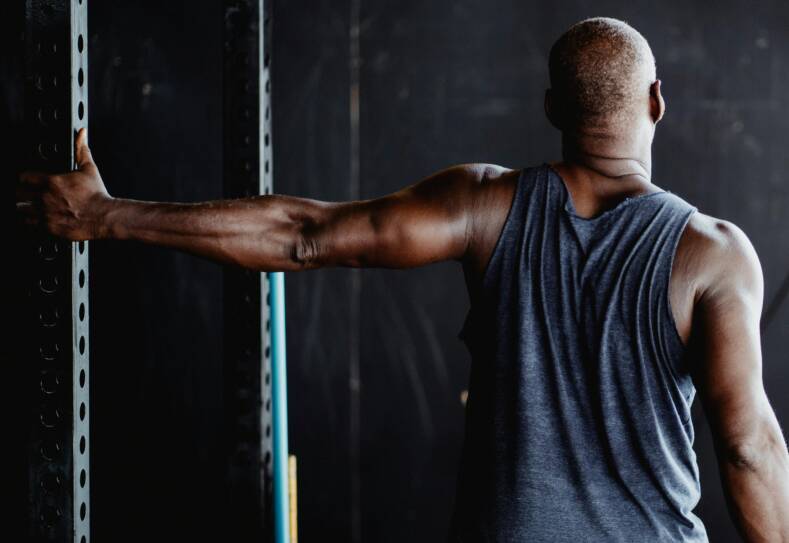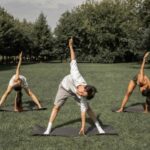Shoulder mobility is a crucial aspect of physical health that contributes not only to the functionality of the upper body but also to its overall well-being. Mobility stretches designed for the shoulders aim to improve flexibility and reduce tightness, thereby enhancing the range of motion. This is particularly significant since the shoulder joint, being one of the most mobile joints in the human body, is also susceptible to injuries and strain due to its complex structure and the demands of daily activities.
Incorporating shoulder mobility exercises into one’s routine can lead to numerous benefits, such as alleviated muscle tension, improved posture, and increased strength and stability of the shoulder muscles. These exercises target different areas of the shoulder, including the rotator cuff and the surrounding muscles and tendons. By practicing these stretches consistently, individuals may notice an ease in performing overhead activities, a reduction in discomfort, and a lowered risk of shoulder-related injuries.
Benefits of Shoulder Mobility Stretches
Shoulder mobility stretches are essential for maintaining flexibility, ensuring joint health, and improving daily function. These benefits are particularly critical for individuals with sedentary lifestyles or those who engage in repetitive upper body movements.
Enhanced Range of Motion
Regular stretching can lead to an enhanced range of motion in the shoulder joints. It allows individuals to perform overhead activities with greater ease and reduces the sensation of stiffness during movement.
- Exercises such as shoulder rolls and cross-body arm stretches actively work to increase the shoulders’ ability to move through their full range of motion.
Reduction of Pain and Tightness
Stretching can alleviate pain associated with tight shoulders. It can also minimize discomfort that stems from muscle imbalances or overuse.
- Techniques like the doorway stretch specifically target muscles around the shoulder, promoting relaxation and reducing muscle tension.
Prevention of Injury
Consistent shoulder mobility exercises can help in the prevention of injury. They do this by strengthening the surrounding muscles and promoting stability within the shoulder girdle.
- Routine including exercises like reverse flies and standing rows can bolster the rotator cuff muscles, which offer support and reduce the risk of strains or sprains.
Understanding Shoulder Anatomy
The shoulder is a complex structure consisting of joints, muscles, and tendons working harmoniously to afford a wide range of motion. It’s essential to understand the shoulder’s anatomy to grasp how mobility exercises impact this intricate system.
Muscles Involved in Shoulder Mobility
The shoulder joint is supported by various muscles including the deltoids, pectorals, and biceps. Foremost are the deltoids which cover the shoulder and consist of three separate sections: anterior, middle, and posterior. Each part aids in different movements such as lifting and rotating the arm. The pectoralis major, located on the chest, also plays a vital role, especially in movements that bring the arm closer to the body. Meanwhile, the biceps brachii, aside from being primarily responsible for flexing the elbow, assists in stabilizing the shoulder during movement.
- Deltoids: Anterior, Middle, and Posterior fibers
- Pectoralis Major: Assists with arm flexion
- Biceps Brachii: Stabilizes shoulder joint
The Role of the Rotator Cuff
The rotator cuff is a group of muscles and tendons enveloping the shoulder joint, enabling the arm to rotate and maintain stability. These structures include:
- Supraspinatus: Elevates the arm and stabilizes the shoulder.
- Infraspinatus: Facilitates arm rotation away from the body and stabilizes the shoulder.
- Teres Minor: Works in conjunction with the infraspinatus to rotate the arm laterally.
- Subscapularis: Rotates the arm towards the body and stabilizes the front of the shoulder.
Each muscle of the rotator cuff coordinates to counterbalance the arm’s actions, ensuring smooth and controlled movement within the joint’s socket.
Importance of Scapulae Alignment
Proper alignment of the scapulae, commonly known as the shoulder blades, is crucial for efficient shoulder mechanics. The scapulae connect the humerus (arm bone) with the clavicle (collarbone) and anchor several muscles that contribute to the shoulder’s motion. Misalignment or instability of the scapulae can impair mobility and potentially lead to discomfort or injury. Exercises that involve the elevation (lifting), protraction (moving forward), depression (lowering), and retraction (pulling back) of the shoulder blades can greatly enhance stability and mobility.
Key Shoulder Stretches for Mobility
Proper shoulder stretches can enhance flexibility, improve range of motion, and reduce the risk of injury. These specific stretches target the muscles and tendons around the shoulder joint.
The Doorway Stretch
The Doorway Stretch is an effective exercise for opening the chest and shoulders. One performs it by standing in a doorway with forearms placed on the doorframe, elbows at shoulder height. They then step forward with one foot, lean into the stretch, and hold for 15-30 seconds. It’s crucial to maintain a straight posture and avoid overarching the back.
The Cross-Body Shoulder Stretch
The Cross-Body Shoulder Stretch addresses the posterior deltoids and rotator cuff muscles. The individual brings one arm across the body at about chest height and uses the opposite hand to slightly pull the arm closer to the chest. Keeping the stretched arm straight or with a slight bend at the elbow, they should feel tension in the shoulder. This stretch should be held for 15-30 seconds on each side.
The Sleeper Stretch
For the Sleeper Stretch, one should lie on their side with the bottom arm extended and the elbow bent at a 90-degree angle. Using the other hand, they gently press down on the raised wrist, bringing the forearm towards the floor. This stretch is crucial for targeting the rotator cuff and should be done carefully to prevent overstretching. Hold the position for 15-20 seconds while ensuring the shoulder stays flush with the ground.
Incorporating Strength Exercises
Strength exercises are a critical component for improving shoulder mobility through muscle conditioning. Incorporating weights and resistance implements into a shoulder routine can not only increase mobility but also enhance stability and power.
Dumbbell Rows and Reverse Flys
Dumbbell rows are essential for targeting the upper back and shoulder muscles, which are pivotal for proper shoulder movement. To perform a dumbbell row, an individual should hinge at the hips keeping the back straight, hold a dumbbell in each hand, and then pull the elbows straight back, squeezing the shoulder blades together. In contrast, reverse flys focus more on the rear deltoids and can be executed by standing with feet shoulder-width apart and a slight bend in the knees. Holding dumbbells, one should lean forward, keeping the back straight and lift the arms to the side, maintaining a slight bend at the elbow.
Resistance Band Workouts
Resistance bands offer a versatile platform for shoulder strengthening due to the variable tension they provide. For exercises like external rotations, one can anchor the band at elbow height, stand with the side to the anchor, and hold the band with the outermost hand. Keeping the elbow close to the body and bent at a 90-degree angle, one then rotates the arm externally, moving the hand away from the anchor. This type of workout targets the rotator cuff muscles essential for shoulder mobility.
Bodyweight Exercises for Stability
Bodyweight exercises are convenient and can be performed anywhere. They strengthen shoulder stabilizing muscles without the need for additional equipment. A standard yet effective exercise is the wall push-up, which is a less intense version of the conventional push-up, suitable for all fitness levels. Facing a wall at arm’s length, one places the hands flat against the wall at shoulder height and then pushes away from the wall by extending the arms.
By integrating these specific strength exercises, individuals can work towards achieving a more balanced and functional shoulder complex.
Warm-Up and Cool-Down
In preparation for any physical activity, proper warm-up exercises enhance shoulder flexibility and reduce the risk of injury. Conversely, cool-down stretches aid in muscle recovery and mitigate post-exercise discomfort.
Dynamic Stretches for Warming Up
Dynamic stretches are ideally performed before engaging in intense physical activities. They prepare the shoulders by increasing blood flow, enhancing the flexibility of the muscles, and improving the range of motion. Here are specific dynamic stretches to incorporate:
- Arm Circles: Start with small circles and gradually increase the size for a set duration.
- Arm Swings: Swing the arms forward and backward, crossing them in front of the body.
It is recommended to perform these exercises for 30 to 60 seconds to ensure the shoulders are adequately warmed up.
Static Stretches for Cooling Down
Post-activity, static stretches are beneficial in reducing muscle tension and promoting relaxation. Unlike dynamic stretches, these are held for a longer period to allow the muscles to loosen and recover. Essential static stretches include:
- Doorway Stretch: Stand in a doorway with arms extended, press the palms forward against the frame, and gently lean into the stretch.
- Cross-Arm Stretch: Bring one arm across the body at shoulder height and use the other arm to apply gentle pressure, enhancing the stretch on the shoulder.
Each static stretch should be held for 15 to 30 seconds, repeating 2 to 4 times on each side to maximize recovery.
Addressing Shoulder Pain and Injury
Effective management of shoulder pain hinges on tailored exercises and adherence to safety protocols during recovery. The right combination of rehab exercises and cautionary measures can mitigate pain and facilitate healing.
Rehab Exercises and Physical Therapy
For individuals suffering from shoulder injuries, physical therapy often plays a crucial role in recovery. Custom rehab exercises, designed by a Doctor of Physical Therapy (DPT), target the restoration of strength and mobility in the shoulder. A typical rehab regimen may include:
- Isometric exercises: These involve contraction of the muscles without moving the joint, aiding in early-stage recovery.
- Range of motion exercises: Gradually increases the mobility of the joint while minimizing pain.
- Strengthening exercises: Aimed at rebuilding the strength of the rotator cuff and surrounding muscles post-injury.
- Stretching routines: To restore flexibility and relieve stiffness, often including gentle stretches that do not aggravate the tear or pain.
Patients should always follow the tailored program provided by their therapist, as each shoulder injury is unique.
Precautions for Shoulder Injury Recovery
Recovering from a shoulder injury necessitates caution to prevent exacerbation of pain or further damage. Patients are advised to:
- Limit activities that stress the injured area.
- Avoid sudden movements that could strain the shoulder muscles and joint.
- Wear a support or brace as recommended by their healthcare provider to stabilize the shoulder.
- Apply ice and heat appropriately to manage pain and inflammation.
Consistency with rehab exercises and following the guidance of a physical therapist is imperative for optimal recovery. It’s important for patients to communicate openly with their healthcare provider about the progression of their pain and mobility throughout the recovery process.
Practical Tips for Everyday Mobility
Maintaining shoulder mobility is essential for daily activities and overall shoulder health. By improving posture and integrating simple tools like foam rollers, one can enhance mobility and reduce the risk of injury.
Improving Posture and Everyday Habits
Good posture is the cornerstone of shoulder health and mobility. Individuals should focus on aligning their ears, shoulders, and hips to promote an erect spine. During everyday activities, they should be mindful of how they carry bags, use their phones, and even how they sleep, as these can all impact shoulder posture. Here are specific habits to adopt:
- When sitting, keep your feet flat on the floor and use a chair that supports your lower back.
- While using a computer, adjust the screen to eye level and keep the mouse close to prevent overreaching.
- Take frequent breaks from any prolonged position to stretch and change posture.
Using Tools Like Foam Rollers
Foam rollers can be a valuable tool for improving shoulder mobility. They work by applying pressure to the muscles and connective tissues, facilitating improved blood flow and flexibility. Here’s how to incorporate them:
- Pre-Exercise: Use the foam roller to warm up shoulder muscles before engaging in exercise, focusing on rolling around the upper back and shoulder blade area.
- Post-Exercise: After workouts, roll out the shoulders to aid in recovery and decrease soreness.
- Consistency: Incorporate foam rolling into your daily routine, not just on exercise days, to maintain and enhance mobility.
Correct exercise form is crucial when using a foam roller. Individuals should roll slowly and avoid direct pressure on bones and joints. By incorporating these practices into daily life, improved shoulder mobility and overall well-being can be achieved.
Special Considerations for Athletes and Aging Adults
Optimal shoulder mobility is crucial for athletes to perform at their peak and for aging adults to maintain an active and pain-free lifestyle. Targeted stretches can enhance athletic performance and help prevent stiffness and degeneration that may accompany aging.
Tailored Stretches for Athletic Performance
Athletes require a shoulder mobility routine that supports their specific sport’s demands, which often involve dynamic and explosive movements. For strength athletes, exercises such as wall slides and external rotations with resistance bands are essential to maintain joint flexibility and prevent injury. These movements enhance the range of motion and build the stability needed for sports that entail overhead activities, like basketball or volleyball.
Track and field athletes might focus on dynamic shoulder swings—both cross-body and overhead—to mimic the actions performed during sport-specific tasks. It’s important these stretches are incorporated both during warm-ups and cool-downs to prime the muscles pre-activity and to facilitate recovery post-activity.
Maintaining Shoulder Health in Aging
Aging individuals often face challenges like arthritis and a natural decline in joint mobility and muscle flexibility. To counter these changes, exercises that are gentle yet effective in maintaining shoulder health are ideal. Shoulder rolls and pendulum swings can be performed daily to encourage circulation and range of motion in the shoulder joints.
For those with more advanced joint issues, low-impact exercises are preferable. Doorway stretches are particularly beneficial, considering they gently stretch the front of the shoulder and chest muscles, areas that often become tight as one ages. Further, incorporating light isometric exercises—where the muscle contracts without moving—can help maintain muscle strength without placing undue stress on the joints.
When designing an exercise regimen for aging shoulders, the integration of flexibility and strength exercises can help protect against injury and improve the overall quality of life by promoting better mobility and reducing pain.








